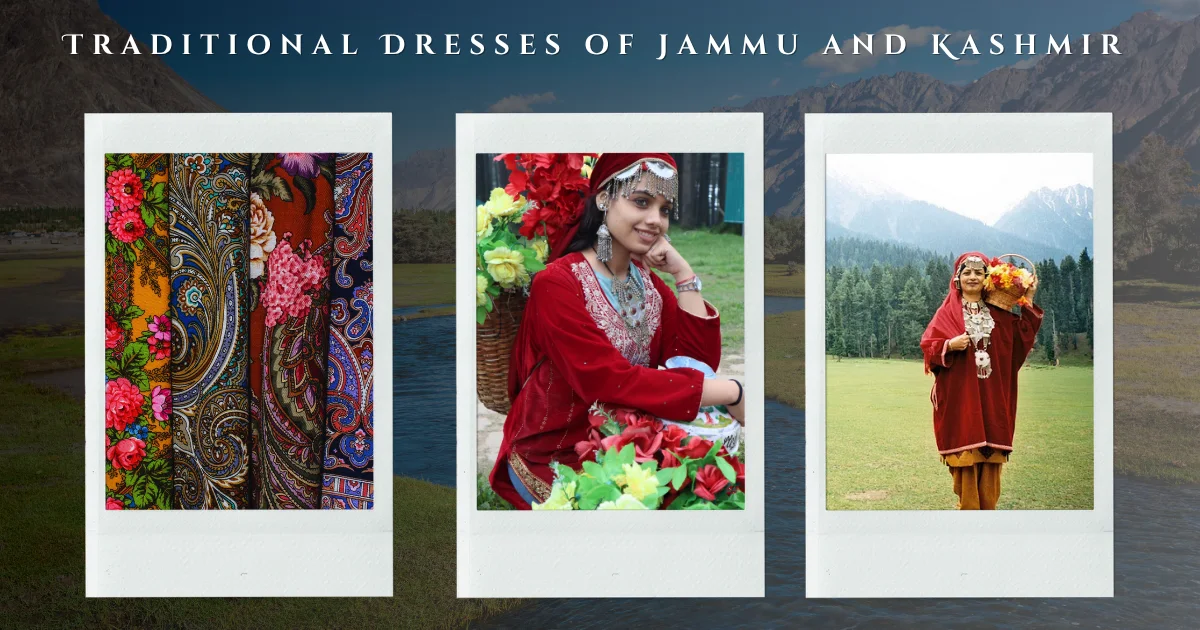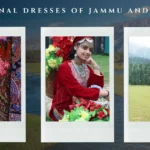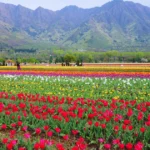When you travel to a new place, learning about its culture makes your journey more special. The traditional dresses of Jammu and Kashmir are not just clothes. They reflect the way people live, their customs, and their beautiful art.
In Jammu and Kashmir, different regions wear different types of traditional clothes. Some are simple and warm for cold weather, while others are colorful and made for special events. Knowing these details helps you enjoy your trip even more.
Table of Contents
ToggleWhat Do Kashmiri Women Wear Traditionally?
Kashmiri women mostly wear a traditional dress called the Pheran.
Features of the Pheran:
-
Long and loose dress that covers the body fully.
-
Made from wool or cotton, depending on the season.
-
Decorated with beautiful embroidery called Tilla work or Aari work.
-
Worn with a scarf called Taranga and earrings called Dejharoo.
You will often see women wearing this in places like Dal Lake, Lal Chowk, and around local temples.
Where to stay nearby to see locals in traditional dress:
-
Hari Bhawan Dharamshala, Srinagar
-
Shri Amarnath Dharamshala, Rainawari
What Is the Traditional Dress for Kashmiri Men?
Kashmiri men also wear the Pheran, but their version is a bit different.
Men’s Pheran:
-
Slightly shorter and often has side openings.
-
Worn with trousers or salwar underneath.
-
Men also carry a Kangri (a small pot with hot charcoal) inside their Pheran to keep warm in winter.
-
They often wear a traditional cap called a karakul.
You can see this dress mostly during winters or in rural areas like Pulwama, Shopian, or Kupwara.
Are the Traditional Dresses Different in Jammu Region?
Yes, the Jammu region has its own style, especially among the Dogra community.
Dogra Women’s Dress:
-
Colorful Ghagra (long skirt), choli (blouse), and a scarf called odhani.
-
Worn during festivals and weddings.
Dogra Men’s Dress:
-
Kurta, churidar, and a traditional turban.
-
Simple and suitable for hot weather.
You can see these during local events and near temples like Raghunath Mandir in Jammu.
What Do Gujjar and Bakarwal People Wear?
The Gujjar and Bakarwal tribes are nomadic and live in the mountains.
Their Dress:
-
Women wear bright long skirts and tops, often decorated with mirrors and beads.
-
Men wear long woolen coats called chogas and wrap cloth around their heads like a turban.
They wear these clothes during daily work and while traveling with their animals through mountain paths. You may see them if you trek through Rajouri or Doda areas.

What Do People Wear in Ladakh Region?
Ladakh has a different style due to its location and Buddhist culture.
Ladakhi Dress:
-
Long robe called Goncha tied with a belt.
-
Perak: Headgear with turquoise stones worn by women.
-
Warm boots and jewelry made from stones.
These dresses are seen during the Hemis Festival and in monasteries around Leh and Nubra Valley.
Can Tourists Buy or Wear These Traditional Dresses?
Yes, you can try or buy these dresses during your visit.
Where to find them:
-
Lal Chowk, Polo View Market in Srinagar.
-
Handicraft shops in Jammu.
-
Some shops near Dal Lake rent them for photoshoots.
New update for 2025:
New craft villages and government stores have opened in Ganderbal and Kupwara, offering cultural experiences for tourists.
When Do Locals Wear Traditional Dresses the Most?
Though many wear these dresses daily in rural areas, you’ll see them most during:
Special Occasions:
-
Festivals like Eid, Diwali, Navroz, and Baisakhi.
-
Weddings and religious events.
-
Winter fairs and cultural festivals.
In 2025, the J&K Government has started “Cultural Dress Days” in schools and offices to keep the tradition alive.
Can I Stay at Dharamshalas to See Real Local Culture?
Yes. Dharamshalas are simple and budget-friendly places to stay. Many of them are located near temples and local areas where you can see people wearing traditional clothes.
Recommended Dharamshalas:
-
Shri Mata Vaishno Devi Dharamshala, Katra
-
Shri Hari Bhawan, Srinagar
-
Shri Raghunath Dharamshala, Jammu
-
Amarnath Yatra Dharamshala, Pahalgam
These places are clean, peaceful, and give you a closer view of local life.
Why Are These Dresses Important to Jammu and Kashmir’s Culture?
These clothes are part of the state’s identity. Every community has its own dress, which shows their traditions, religion, and way of living.
Cultural Importance:
-
The Pheran comes from Mughal influence.
-
Kangri is a sign of Kashmiri warmth and care.
-
Dogra turbans show pride and history.
-
Ladakhi headgear has spiritual meaning.
In 2025, the government is also supporting weavers through handloom fairs, training centers, and local markets.
When Is the Best Time to See People in Traditional Dresses?
Plan your visit during local festivals or religious seasons to see the Traditional Dresses of Jammu and Kashmir in full beauty.
Best Times to Visit:
-
March–April: Tulip Festival, Navroz
-
May–July: Wedding Season
-
December–January: Winter snow festivals
Latest 2025 Updates:
-
Gurez and Doodhpathri now open to tourists.
-
Direct train to Banihal from other cities.
-
New roads and travel facilities in Samba and Bandipora.
Conclusion
The Traditional Dresses of Jammu and Kashmir tell stories of beauty, pride, and tradition. Every thread, color, and design has meaning. When you visit Jammu and Kashmir, take time to notice what people wear—it will help you feel more connected to the land and its people.
Let Kashmir Tour Package help you discover this rich culture with comfort and care.
FAQs (Click to Expand)
1. What is the most common traditional dress in Kashmir?
The Pheran is the most common traditional dress worn by both men and women in Kashmir.
2. Can tourists rent traditional clothes in Srinagar?
Yes, many shops near Dal Lake and tourist spots offer traditional clothes for rent and photos.
3. Do locals still wear traditional clothes every day?
Yes, especially in villages and during winters or festivals.
4. Where can I buy real Pashmina shawls?
Visit government-certified stores or markets in Srinagar like Lal Chowk for genuine products.
5. What is new in tourism in Jammu & Kashmir in 2025?
New tourist areas like Gurez have opened. More trains and roads are now available for easy travel.




